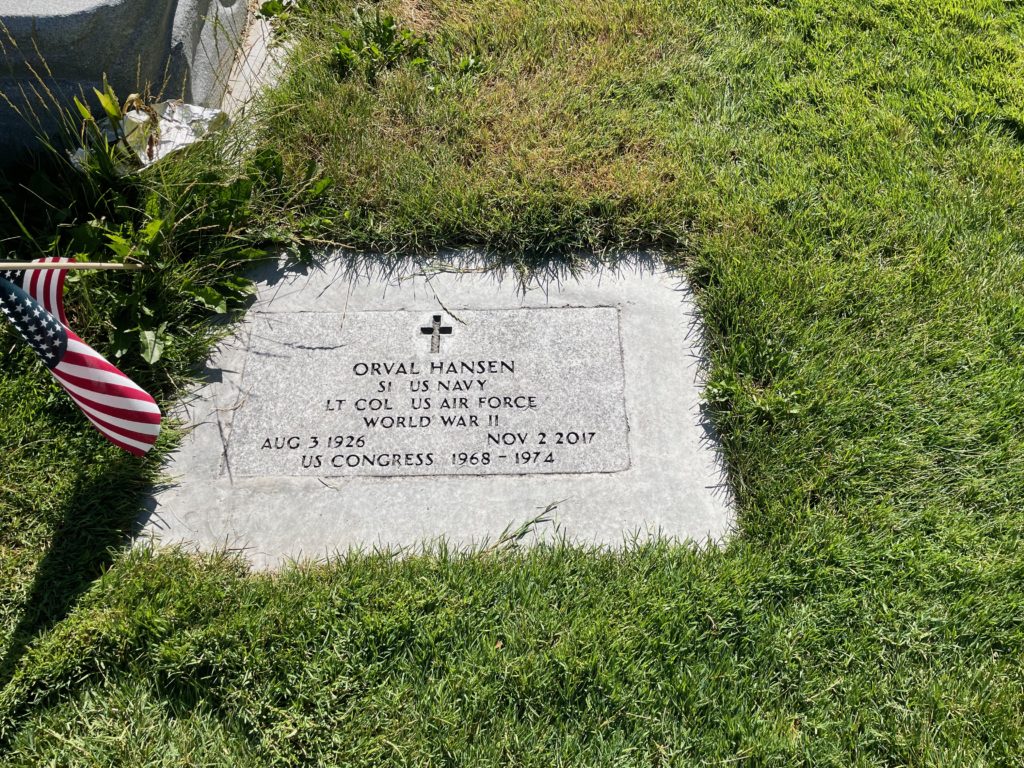Erik Visits an American Grave, Part 1,200
This is the grave of Orval Hansen.

Born in 1926 in Firth, Idaho, Hansen was the son of Scandinavians, a child of both Norwegians and Danes. We all know what that kind of mongrelization leads to–Republicans. He grew up in Idaho Falls and went to high school there, where he finished in 1944. He was briefly in the military at the end of World War II but doesn’t seem to have seen much combat while serving on an aircraft carrier. He was discharged in 1946 but stayed in the Reserves all the way until 1979, by which time he had reached the rank of lieutenant colonel.
Hansen returned to Idaho and went to college at the University of Idaho in Moscow. He graduated in 1950 and then went to law school at George Washington University, where he graduated in 1954. He passed the bar back in Idaho and then like so many politicians, used that law degree as a springboard into the political world. He got elected to the state house in 1956 as a Republican and became House Majority Leader in 1961. It’s worth noting here that while Idaho has always been a pretty conservative state, during this era, it was nowhere near as crazy as it is today. At that time, there was a large Democratic presence, especially in northern Idaho. The ranchers and the Mormons were certainly quite conservative and that meant Idaho was often governed by Republicans but Democrats such as Frank Church or Cecil Andrus could develop their own political dynasties by being quite liberal but idiosyncratic enough to attract a few conservatives. And even when Republicans did hold power, as they often did, it wasn’t the insane kind of Republican that defines the contemporary Idaho of Helen Chenoweth and Raul Labrador and even Larry Craig, who was a troll even when he was in the statehouse.
So Hansen was a conservative, but he wasn’t what you think of today when you think of Idaho Republicans. In fact, his own district was reasonably liberal. He later said of his time in the legislature, “We wore our partisan labels lightly in the Idaho Legislature. Party line votes and angry words in debate were rare. We played partisan games in fun mainly to keep up our morale. Debate could be spirited but it was civil. Friendships extended across the aisle.” This might be nostalgic and played up too much, but it really was a different era, especially in the age when there were Republican liberals and conservative Democrats, at least on some issues.
Hansen lost his first attempt to go to Congress, in 1962, to the Democratic candidate Ralph Harding. So he went back to the statehouse for a couple more terms, including one in the state Senate. In 1968, George Hansen (no relation) was the Republican congressman in that district and he decided to take on Frank Church for the Senate. Church kicked his ass, but this left an open seat and Orval Hansen won the Republican nomination and then the general election.
While in Congress, Hansen was, well, just a guy. There are so many congresscritters that are completely forgettable and Hansen was one of them. He was a member of the House Committee on Education; Labor, House Administration Committee and the Joint Committee on Atomic Energy. He was good at taking care of his district. One of the big controversies in Idaho at this time was what to do with the Sawtooths, the beautiful range of mountains in the middle of the state. Some wanted to turn it into a national park, some wanted to protect it but keep out the insane crowds and roads of national parks, and some wanted the ranchers to reign supreme. Hansen was a central figure in all of this, working with Church and Len Jordan and others to create the Sawtooth National Recreation Area as a compromise measure that has mostly served the region well to the present. He also was a big proponent of the Idaho National Engineering Laboratory, one of the nation’s nuclear defense national laboratories. If INEL isn’t as important to the nation’s history as Hanford or Los Alamos, it wasn’t because Hansen didn’t fight for resources for it, for he most certainly did. He got involved in Vietnam issues to the extent that he was among the congressmen known for spending time on fixing the many problems of the war.
In 1974, Hansen lost his reelection bid in the primary to George Hansen, who was popular and wanted his old seat back. After Hansen left Congress, he decided to go back to his studies and entered the PhD program in political science at George Washington. He completed his dissertation in 1986. Must have been interesting to be in class with an ex-Congressman, even as Hansen was no star. He also started his own law practice and founded something called the Columbia Institute for Political Research. That was designed to promote bipartisan policy solutions and other Beltway blah blah blah. He also became a big time mountain climber and marathon runner.
Hansen eventually retired to Boise. He died of cancer in 2017 at the age of 91.
Orval Hansen is buried in Pioneer Cemetery, Boise, Idaho.
If you would like this series to visit other congresscritters elected in 1968, you can donate to cover the required expenses here. William Cahill (NJ-6) is in Cherry Hill, New Jersey and James Colgate Cleveland (NH-2) is in New London, New Hampshire. Previous posts in this series are archived here.


